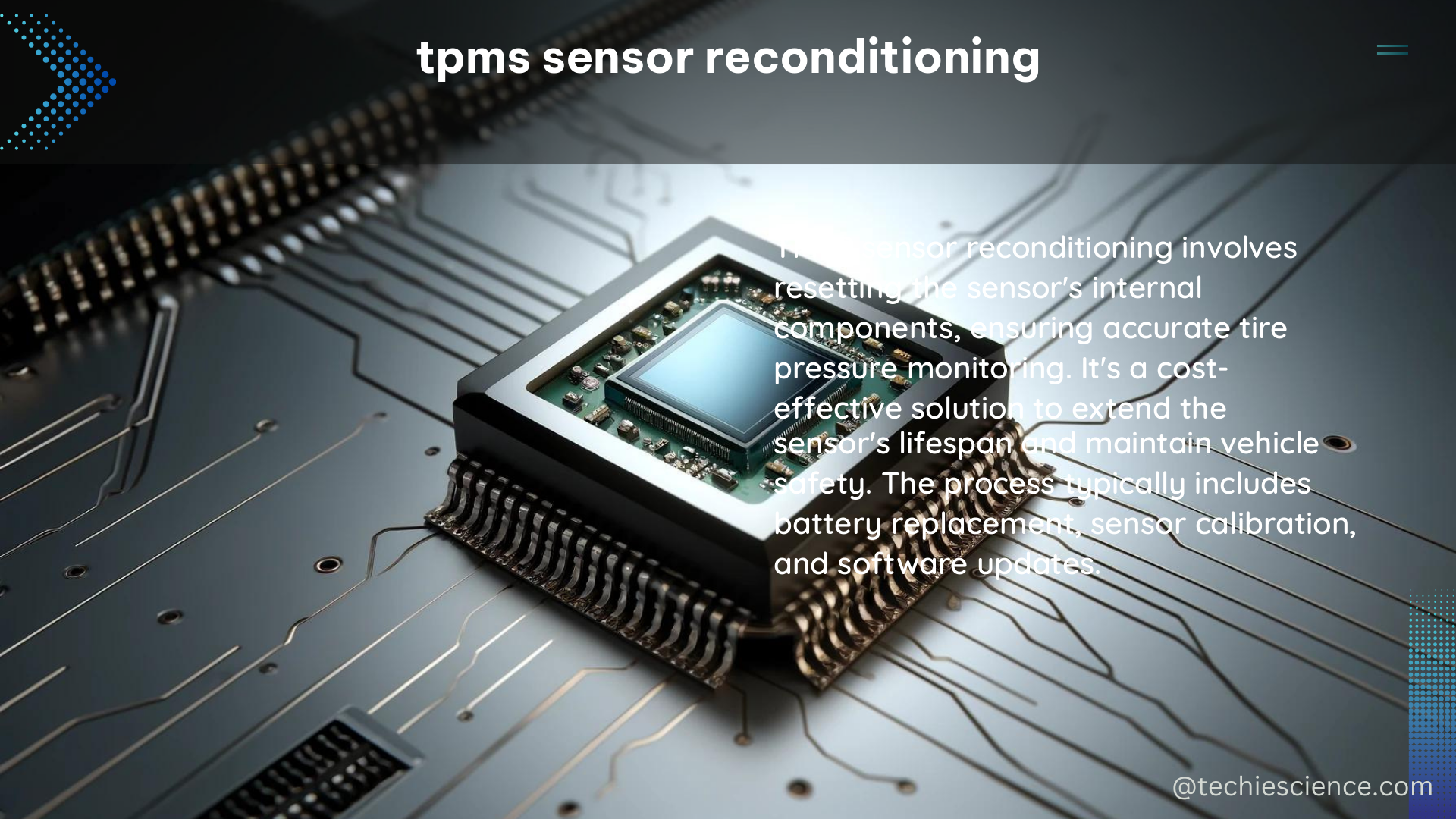TPMS (Tire Pressure Monitoring System) sensors are critical components of modern vehicles that help monitor tire pressure to ensure safety, fuel efficiency, and environmental sustainability. Reconditioning TPMS sensors is a cost-effective alternative to replacing them, and it involves restoring the sensors to their original performance specifications. This process requires advanced knowledge of sensor technology, hands-on skills, and strict adherence to technical specifications.
Understanding TPMS Sensor Reconditioning Metrics
Measurable and quantifiable data on TPMS sensor reconditioning include:
Sensor Responsiveness
TPMS sensors must respond quickly and accurately to changes in tire pressure. The reconditioning process should ensure that the sensor’s response time is within the manufacturer’s specified range, typically measured in milliseconds. For example, a high-performance TPMS sensor should have a response time of less than 50 milliseconds, while a standard sensor may have a response time of up to 100 milliseconds.
Sensor Accuracy
TPMS sensors must provide accurate pressure readings. The reconditioning process should ensure that the sensor’s accuracy is within the manufacturer’s specified tolerance, typically +/- 1 psi or 1% of the tire pressure. This means that a sensor with a tire pressure of 35 psi should have an accuracy of 34-36 psi.
Sensor Durability
TPMS sensors must withstand harsh environmental conditions, such as extreme temperatures, moisture, and vibrations. The reconditioning process should restore the sensor’s durability to the manufacturer’s specified standards, typically measured in hours of operation or number of duty cycles. For instance, a durable TPMS sensor should be able to withstand at least 10,000 hours of operation or 1 million duty cycles.
Sensor Range
TPMS sensors must have a sufficient range to communicate with the vehicle’s onboard computer. The reconditioning process should ensure that the sensor’s range is within the manufacturer’s specified range, typically measured in feet or meters. A high-performance TPMS sensor should have a range of at least 100 feet (30 meters), while a standard sensor may have a range of 50 feet (15 meters).
Sensor Frequency
TPMS sensors must transmit pressure readings at a specified frequency. The reconditioning process should ensure that the sensor’s frequency is within the manufacturer’s specified range, typically measured in hertz or cycles per second. A common TPMS sensor frequency is 315 MHz or 433 MHz, with a tolerance of +/- 30 kHz.
DIY TPMS Sensor Reconditioning: Tools and Process

DIY TPMS sensor reconditioning requires specialized tools and equipment, such as:
- TPMS sensor activation tools: Used to activate the sensor and verify its communication with the vehicle’s onboard computer.
- TPMS sensor programming tools: Used to program the sensor’s unique identifier and communication protocol.
- TPMS sensor calibration tools: Used to calibrate the sensor’s pressure readings to ensure accuracy.
The reconditioning process typically involves the following steps:
-
Sensor Disassembly: Carefully disassemble the sensor, taking note of the orientation of the components for reassembly. This may involve using specialized tools, such as a TPMS sensor disassembly kit, to avoid damaging the sensor.
-
Component Cleaning: Clean the sensor components using a recommended cleaning solution, such as isopropyl alcohol, and a soft brush. Ensure that all contaminants are removed without damaging the sensor’s delicate components.
-
Component Inspection: Inspect the sensor components for signs of wear, damage, or contamination. Replace any damaged or contaminated components, such as the battery, the pressure sensor, or the antenna, with genuine manufacturer-approved parts.
-
Sensor Reassembly: Reassemble the sensor, ensuring that the components are properly aligned and secured. This may require the use of specialized tools, such as a TPMS sensor reassembly kit, to ensure a proper fit and prevent damage.
-
Sensor Calibration: Calibrate the sensor using a TPMS sensor calibration tool, ensuring that the sensor’s pressure readings are accurate and within the manufacturer’s specified tolerance. This may involve adjusting the sensor’s pressure offset or gain.
-
Sensor Programming: Program the sensor using a TPMS sensor programming tool, ensuring that the sensor’s unique identifier and communication protocol are correctly configured. This may involve using a TPMS sensor programming software or a dedicated programming device.
-
Sensor Activation: Activate the sensor using a TPMS sensor activation tool, ensuring that the sensor is communicating with the vehicle’s onboard computer. This may involve verifying the sensor’s signal strength, frequency, and other parameters.
Throughout the reconditioning process, it is essential to follow the manufacturer’s technical specifications and guidelines to ensure the sensor’s performance and reliability. Failure to adhere to these specifications may result in inaccurate pressure readings, communication issues, or even sensor failure.
Conclusion
TPMS sensor reconditioning is a critical process that requires advanced knowledge, skills, and equipment. Measurable and quantifiable data, such as sensor responsiveness, accuracy, durability, range, and frequency, are essential for ensuring the sensor’s performance and reliability. DIY TPMS sensor reconditioning is possible with the right tools and equipment, but it requires careful attention to detail and strict adherence to the manufacturer’s technical specifications.
By following the guidelines and best practices outlined in this comprehensive playbook, DIY enthusiasts can successfully recondition their TPMS sensors, saving money and ensuring the continued safety, fuel efficiency, and environmental sustainability of their vehicles.
References:
– TPMS Sensor Activation Tool Buyer’s Guide
– TPMS Sensor Programming and Calibration Guide
– TPMS Sensor Disassembly and Reassembly Guide
– TPMS Sensor Accuracy and Tolerance Specifications
– TPMS Sensor Durability and Environmental Specifications

The lambdageeks.com Core SME Team is a group of experienced subject matter experts from diverse scientific and technical fields including Physics, Chemistry, Technology,Electronics & Electrical Engineering, Automotive, Mechanical Engineering. Our team collaborates to create high-quality, well-researched articles on a wide range of science and technology topics for the lambdageeks.com website.
All Our Senior SME are having more than 7 Years of experience in the respective fields . They are either Working Industry Professionals or assocaited With different Universities. Refer Our Authors Page to get to know About our Core SMEs.